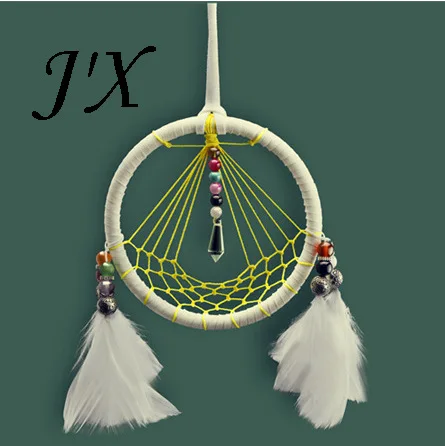American Indian Dream Catcher
- American Indian Dream Catchers Line Art Free
- American Indian Dream Catchers Tattoos
- Native American Indian Dream Catchers
- Indian American Dream Catcher

This Native American dream catcher is an authentic Navajo Indian dreamcatcher made with the popular rustic deer skin leather, beads and feathers. The webbing of the dream catcher is woven by hand and includes a piece of real turquoise. Dreamcatchers are recognized as a symbol of unity among the various Indian Nations, and are a general symbol of identification with Native American or First Nations cultures.


Dream Catchers |
American Indian Dream Catchers Line Art Free
| 1. Start with a 2 - 6 ft. length of fresh Red Willow (Red Osier Dogwood), or soaked Grapevine (dried grapevine is available in the craft department of many stores) Carefully bend the vine around to form a circle with a 3 - 8 in. diameter. You decide on the diameter, but traditionally dreamcatchers are no wider than adult's hand. 2. If you are using thin Red Willow or grapevines, twist the piece you are bending, around the circle you have made to strengthen the hoop. |

| 3. Use 4-16 ft. of strong but thin string (the length is determined by the diameter of the hoop). Knot a loop in one end from which you will hang your dream catcher when it is done. 4. Tie the hanging loop around the top of your dream catcher (or at the weakest point of your hoop). |
| 5. The dream catcher repeats the same stitch from start to finish. To start, hold the string and place it loosely over the top of the hoop. Move the string around to the back of the hoop (forming a hole) and pull the string back through the hole you just made. |
| 6. Pull each stitch taught but not too tight or it will warp the hoop of the dream catcher and it will not lie flat when it is done. |
| 7. Continue the same stitch for the first round around the hoop of the dream catcher. Space the stitches evenly, about 1 1/2 to 2 in. apart (making 7 to 13 stitches around the hoop). 8. The last stitch of the first round should be placed about a half inch away from the the hanging loop. |
| STITCH FOR THE SECOND ROUND: 9. On the second and subsequent stitching rounds, place the string around the center of each stitch from the previous round (rather than around the hoop). 10. As you pull each stitch tight, the string from the previous round should bend towards the center of the hoop slightly, forming a diamond shape. You should see the spider web beginning to form. 11. On the third or fourth round add a bead to represent the spider in the web. Simply place the bead on your string and continue stitching as usual. |
| 12. Continue stitching towards the center of the hoop. Eventually, the stitches become so small that it is difficult to pass the string through. Make sure you leave a hole in the center of the dreamcatcher. 13. Stop stitching at the bottom of the hole in the center of the dream catcher. End by stitching twice in the same place, forming a knot, and pull tight. |
| 14. You should have 6 - 8 in. of string to tie 2 or 3 feathers which dangle from the center of the dreamcatcher. Tie on 2 or 3 feathers and knot. |
| 15. Wrap a 1 in. square of felt around the knot of string and over the base of the feathers. Tie two 4 In. pieces string around the wrapped felt. 16. Hang over sleeping place. Sweet Dreams!! |
Branches, Twigs & Roots Bibliography and Books to Buy On-Line
| Text and Graphics © 1994 - Tara Prindle unless otherwise cited. |
Celebrated for their striking geometric spider-web design, the dream catcher was originally the product of Ojibwe Indian culture, as a means of ultimate talismanic protection. Its origins lie in Ojibwe legend, which tells of a Spider Woman who protected their people from evil forces. The dream catcher was created to honor this legend, designed as a symbolic means to snare evil forces and particularly bad dreams.
American Indian Dream Catchers Tattoos
The creation of a dream catcher traditionally begins with a hoop constructed from willow. On to this hoop a loose, woven mesh, akin to a spider web, of fiber made from either animal tissues or plant materials. Following this weaving, the catcher is decorated with both symbolic and sacred objects, such as feathers or beads. Later spread to other tribes, the dream catcher is recognized today as a powerful and persevering symbol of American Indian history that continues to delight.
Quick Facts
Native American Indian Dream Catchers
- In the Ojibwe language, a dream catcher is referred to as a “asabikeshiinh,” which translates roughly to “spider”
- Though the dream catcher carries far back into Ojibwe lore, the first mention in print of their existence was made in anthropologist Francis Densmore’s “Chippewa Customs,” published in 1929
- While the connotations of dream catchers lead to many being suspended over or near beds, they can also be given a symbol of general good luck upon events such as marriage
Indian American Dream Catcher
There are currently no items in American Indian Dream Catchers. Please click another category to see additional items.